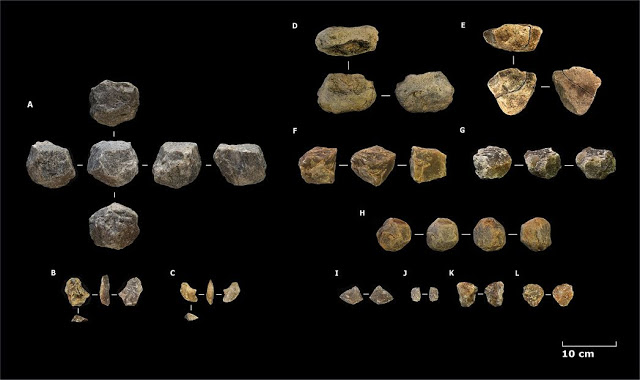07/01/2021
Hominins in Tanzania exploited diverse ecosystems 2 million years ago
This is revealed by a new site, yielding the oldest stone tools documented to date in the Oldupai Gorge

This is revealed by a new site, yielding the oldest stone tools documented to date in the Oldupai Gorge
The article published in Nature Communications, with the participation of IPHES (Institut Català de Paleoecologia Humana i Evolució Social) –CERCA, shows that the first hominins that inhabited Oldupai Gorge (the Maasai name for the renowned Olduvai Gorge, Tanzania) exploited very diverse habitats and ecosystems 2 million years ago.
“This has been known because of the discovery of a set of stone tools, the oldest documented in the Oldupai Gorge to date”, observes María Soto, researcher at MIAS-UAM (Autonomous University of Madrid) and IPHES collaborator. “A multidisciplinary analysis applied to the geoarchaeological record of the Ewass Oldupa (Geolocality 63) has revealed it, being also, the oldest evidence of human occupation of this place known to date ”, adds Julio Mercader, director of the research project and IPHES associated researcher.
The Oldupai Gorge (Tanzania) is an area of great importance for the study of Human Evolution since it has a wide ecological record associated with human occupations by different species of hominins. “Despite being a focus for world archaeological research for over a century, the new article represents a milestone, correlating different palaeoecological data with human activities”, highlights María Soto.

Different African, American and European institutions participate in this research, culminating a multidisciplinary analysis of the stone tools, fauna, teeth and plants isotopes, phytoliths, pollen and charcoals, among other evidence.
The geoarchaeological sequence presented comes from recent excavations carried out during the years 2018-2019 in a relatively unexplored area, the western Plio-Pleistocene basin of Oldupai Gorge.
The Ewass Oldupa record (which in the Maa language means “On the way to the Gorge”) includes the oldest cultural evidence in this paleoanthropological referential site, a lithic assemblage made up of more than 500 tools, dated between 2 and 1.8 million years. It presents Oldowan typical characteristics, with abundant spheroids (ball-shaped tools), and in which the use of hard hammers and multi-faceted reduction strategies are also documented. Geochemical analysis of the stone-tools, using X-ray Fluorescence, place the procurement area of the quartzites used as raw material 12 km away from the site.
A diverse fauna
Pamela Achieng Akuku, who is doing her doctoral thesis at the Rovira i Virgili University (URV) linked to IPHES-CERCA, and funded by the Social Sciences and Humanities Research Council of the Canadian Government, and Palmira Saladié, a IPHES-CERCA researcher, associate professor at this university, and co-director of the thesis together with Julio Mercader, have studied the faunal remains from Ewass Oldupa. These analyses have made possible to recognise a diverse faunal association, in which bovids belonging to different taxonomic families, carnivores such as hyenas and leopards, and aquatic taxa such as turtles, crocodiles or hippos have been identified. Remains of a primate, specifically Theropithecus oswaldi, have also been recorded. It is an extinct species belonging to the same family as the Gelada that currently inhabit the Ethiopian highlands. “This variety -says Pamela Achieng Akuku- has allowed us to infer the existence of open spaces with arboreal mosaics around Ewass Oldupa, where the archaic hominins of the Oldupai Gorge lived”.

So far no hominin fossils have been recovered, although remains of Homo habilis have been found in more recent sediments to the east and west of the ancient lake that occupied the current gorge. “If the authors of the recovered tools were members of this species, or of the genus Paranthropus, who occupied the area during the same period, it remains unknown for the moment”, says María Soto.
The recovered assemblages are associated with the early Pleistocene, proceeding from the post-Naabi geological units to the base of Bed II (between 2 and 1.8 million years ago). The chronology of these units is well known from previous work, and an ongoing dating program of the volcanic materials in which the remains are included.
The different evidences analyzed in this study show that the Oldowan groups showed flexible adaptive capacities, inhabiting highly variable ecosystems, from fluvial habitats in volcanic environments, lake areas with different episodes of transgression / regression, and areas close to small river courses with interspersed episodes with volcanism. Hominins knew how to develop in landscapes with drastic variations from fern meadows to forest mosaics, with frequent natural fires, palm groves by the lake and steppes.
“The continuation of the works in Oldupai Gorge and the application of transdisciplinary research show how studies on human evolution can still provide surprises and evidence to change scientific paradigms”, warns María Soto. This research has verified how adaptability, despite technological persistence, allowed the exploitation of a multitude of habitats in Africa, and later in the rest of continents.
Participants in this research are from the University of Calgary, Manitoba, McMaster and Toronto (Canada), the University of Dar es Salaam and Iringa (Tanzania), the Ministry of Natural Resources and Tourism (Tanzania), the Max Planck Institute for the Science of Human History (Germany), the Institut Català de Paleoecologia Humana i Evolució Social-CERCA, Universitat Rovira i Virgili and the Madrid Institute for Advanced Study-Universidad Autónoma de Madrid (Spain). All these institutions work with the Tanzanian Commission for Science and Technology, the Division of Antiquities (MNRT), and under the sponsorship of the Canadian Social Sciences and Humanities Research Council (Partnership program)
Article
Mercader, J., et al. (2021). “Earliest Olduvai hominins exploited unstable environments ~ 2 million years ago”. Nature Communications, https://doi.org/10.1038/s41467-020-20176-2
